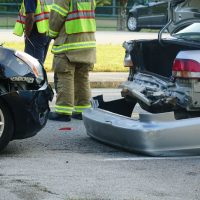Comparative Negligence: How to Determine Liability in an Indiana Car Accident

Car accidents are an unfortunate reality on Indianapolis highways and city streets, often leading to serious injuries and complex legal disputes. One of the key issues in any car accident case is determining liability, or who is at fault. In most instances, Indiana follows a legal doctrine of modified comparative negligence, which plays a crucial role in resolving these disputes. Understanding how comparative negligence works is essential for anyone involved in a car accident in Indiana. Read on as we discuss the ins and outs of this vital issue. If you or a loved one were injured in a car accident in Indiana, contact Lee Cossell & Feagley to speak with a skilled and experienced Indianapolis auto accident lawyer.
What Is Comparative Negligence?
Comparative negligence is a legal principle that allows multiple parties to share the blame for an accident. In Indiana, this principle is governed by the state’s Modified Comparative Fault law. Under this law, each party’s degree of fault is assessed, and their compensation is adjusted accordingly.
Indiana uses a “51% Bar Rule” in its comparative negligence system. This means that if you are found to be more than 50% at fault for the accident, you cannot recover any damages. However, if you are 50% or less at fault, you can still recover damages, but your compensation will be reduced by your percentage of fault.
For example, if you were in a car accident and found to be 30% at fault, and your total damages amount to $100,000, you would only be able to recover $70,000. Conversely, if you are found to be 51% at fault, you would not be entitled to any compensation.
One important exception to this rule is when the crash involves a government vehicle or vehicle driven by a government employee while on duty. In cases involving a governmental entity, Indiana applies a pure contributory negligence rule, where any amount of negligence on your part – even one percent – would bar you from a recovery against the government, even if they were mostly to blame.
Determining Fault in a Car Accident
Determining fault in a car accident involves a thorough investigation of the circumstances surrounding the crash. Here are some of the key factors that come into play:
-
Police Reports: A police report is often one of the first pieces of evidence examined. It provides an official account of the accident, including any citations issued and observations made by the responding officers.
-
Witness Statements: Eyewitnesses can provide valuable information about how the accident occurred. Their statements can corroborate or challenge the accounts provided by the drivers involved.
-
Physical Evidence: Skid marks, vehicle damage, and road conditions can all offer important clues about the accident. Accident reconstruction experts may analyze this evidence to determine the sequence of events.
-
Traffic Laws: Violations of traffic laws, such as speeding, running a red light, or failing to yield, can strongly indicate fault. The presence of such violations can significantly influence the determination of liability.
-
Driver Statements: Statements made by the drivers involved can also impact the determination of fault. It’s important to be cautious when speaking to insurance adjusters or others after an accident, as your words can be used against you.
How to Protect Your Interests After an Indianapolis Car Accident
Understanding how comparative negligence affects your claim is crucial for navigating the aftermath of a car accident. Here are some steps to help protect your interests:
-
Document Everything: Take photos of the accident scene, your injuries, and any property damage. Collect contact information from witnesses and keep detailed records of medical treatments and expenses.
-
Seek Medical Attention: Even if your injuries seem minor, it’s important to seek medical attention promptly to make sure all your injuries are identified. This ensures that your injuries are properly documented and treated.
-
Consult an Attorney: An experienced personal injury attorney can help you understand your rights and navigate the complexities of a comparative negligence claim. They can gather evidence, negotiate with insurance companies, and advocate on your behalf.
-
Avoid Admitting Fault: Be careful about what you say at the accident scene and afterwards. Even seemingly innocent statements can be misconstrued as admissions of fault.
Contact Lee Cossell & Feagley After a Car Accident Injury in Indianapolis
Determining liability in an Indiana car accident can be a complex process, especially under the state’s comparative negligence laws. Understanding how these laws work and taking the right steps after an accident can significantly impact the outcome of your claim. At Lee Cossell & Feagley, LLP, we have the experience and expertise to help you navigate this challenging process and fight for the compensation you deserve. If you’ve been involved in a car accident, contact us today for a free consultation. Let us help you on the road to recovery.


